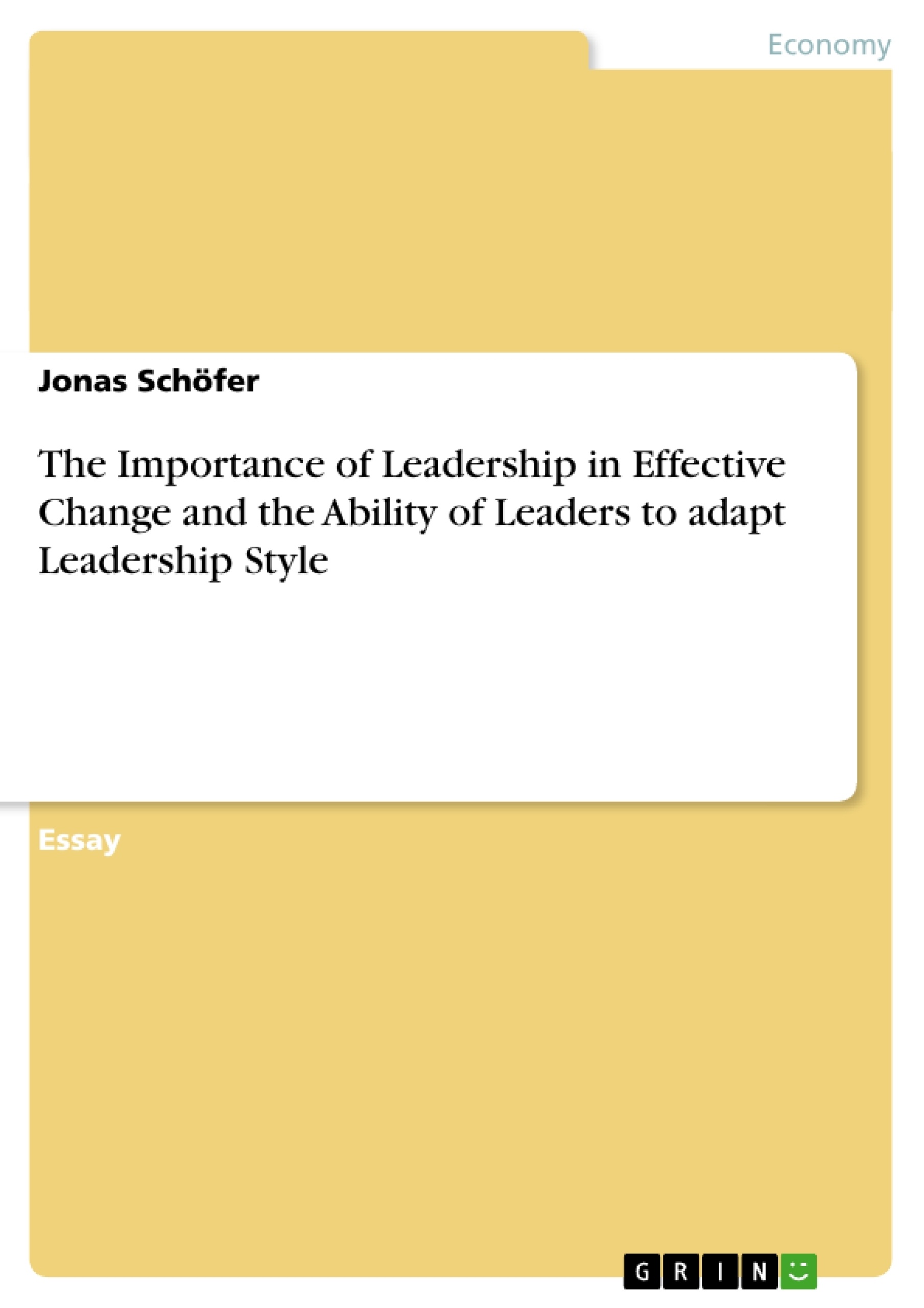“Human beings, by changing the inner attitudes of their minds, can change the outer aspects of their lives.”, William James (1842-1910)
This essay will show that leadership plays an important role in effective organisa- tional change. In addition, the author will show that disability of leaders to adapt their leadership style to the strategy does have a negative impetus on organisational effec- tiveness.
Bennis (1985) suggested that one of the key predictors of business success is effec- tive leadership and that ineffective leadership often is a predictor of an organization's failure. Therefore, it is important to all organizations that they understand the role of leadership and that they identify the styles of leadership most effective to their busi- nesses.
After introducing into the theoretical background of change processes and their effec- tiveness, the theories of several authors including Lewin, Dunphy & Stace and Clarke concerning change leadership and situational leadership will be analysed. After that, several case studies from civil as well as military organisations will be provided. In the end, all arguments will be summed up in the conclusion.
Effective Change means changing an organisation’s technology, products and ser- vices, strategy, structure and culture so that the needs and demands of the environ- ment comprising customers, competition, legislation, regulation and labour force as well as the needs of the organisation’s members are met. Daft (2002, p.358) names 5 elements for effective change: Firstly, ideas are needed for changing the present system. These ideas such as process improvements can come from the inside as well as from the outside. Secondly, needs pose the actual necessity for change and adaptation if the members of the organisation or outsiders perceive a gap between actual performance and present or future expectations. These needs can emerge during a constant desire for development or an actual crisis because of rapid envi- ronmental or technological change. Thirdly, the members of the organisation have to
adopt the need for change and the proposed ideas. Fourthly, the ideas have to be transferred to the internal system and implemented. Without implementation, no change has occurred. Lastly, sufficient resources are needed for effective change. Products need to be researched or employees have to spend time on improving their processes.
Change can occur planned as well as unplanned. Successful strategies base on a proactive and intended organisational change for making the organisation ready for expected changes in the environment. If the management fails to foresee certain changes in the environment, unplanned and thereby reactive change occurs or has to occur. These changes in the environment can either trigger a continuous and incre- mental change or a radical change. Incremental change (or “Evolution”) usually only affects parts of the organisations, is borne by normal structures and management processes and results in technology or product improvements. On the other hand, radical change (or “Revolution”) is triggered by paradigm-breaking bursts, transforms the entire organisation, including new structures and management. Radical change usually results in breakthrough technology advancements and new products or new market opportunities (Meyer, Goes and Brooks 1992, pgs. 66-111).
Several theorists have analysed the importance of leadership in an effective change process. McShane and von Glinow (2000, pgs.450-451) name the importance of a “Transformational Leader” to bring about effective change in the organization’s strategies and culture so that they have a better fit with the surrounding environment. A transformational leader acts as an agent of change by developing visions and in- spiring their employees with this vision.
Noel Tichy (1984, pgs. 59-68) combines the definition of a transformational leader with a need for a radical change caused by changes in an organisation’s technology, people or environment: The strategic change as planned by the transformational leader(s) results in a non-routine, non-incremental and discontinuous change which alters the overall orientation of the organisation or parts of it.
The Force-Field model developed by Kurt Lewin (1951) helps to understand the change process and the leader’s role in it: Every change process underlies driving forces as well as restraining forces. Driving forces can be needs for change originat- ing from within or outside the organisation such as technology developments, compe- tition or new leadership/management styles. Restraining forces are predominantly of a psychological source, but also cost restraints e.g. for new computers apply. The psychological reasons are mainly deriving from Fear, Uncertainty and Doubt – often called the “FUD Factor”. The role of leadership becomes important when the change process has to be started: No change occurs if the forces are in equilibrium. To bring about change, the driving forces have to be stronger than the restraining forces. Leaders can increase the driving forces while reducing the restraining forces by ade- quate management decisions. Lewin’s position that leaders have to reduce the re- straining forces for starting an effective change process is bolstered up by Piet- ersen’s “Mark Twain Dilemma” (2002): Everybody knows that change and develop- ment has to be a part of organisational effectiveness. However, people involved in change processes are often afraid of losing their jobs, their position or having to leave their “zone of comfort”. Mark Twain perfectly expressed this with his quote "You know, I'm all for progress. It is change I object to." After the change process has been started, the system is being “unfrozen” in Lewin’s terminology. In the following “Movement Stage” the leaders and members of the organisation have to adopt the right changes to the existing system, although the ideas do not necessarily have to come from the leaders (“Top-Down”) but can also be named by the employees (“Bot- tom-Up”) as later shown in the Shell-Case. After reaching the desired state, the or- ganisation has to be “Refrozen” by adequate leadership actions to remain in that state and develop efficiency strategies in the new state.



